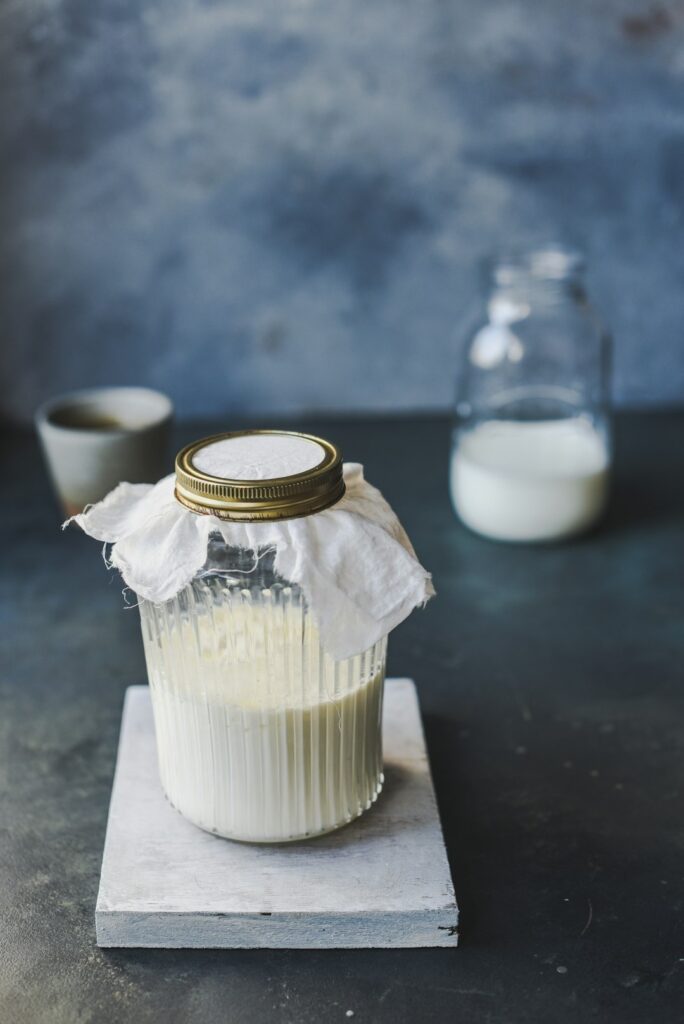Yogurt & Kefir
Yogurt may be the most popular fermented food in our western culture today. Sometimes it is difficult to find our ideal yogurt as many of them have been fat-reduced, sweetened or pasteurized to the point that we are not receiving their full benefits.

That’s why it is so beneficial to start culturing our own yogurt, and that way we can make it just the way we like it. The organism that cultures within yogurt is typically a Lactobacillus species such as Lactobacillus acidophilus or bulgaricus but you will often see many different cultures listed in the ingredients of store-bought yogurt (and this is a good thing).
Yogurt also generally contains Streptococcus thermophilus which helps cause the yogurt to thicken and coagulate. This organism is most active above body temperature, around 110°F or 43°C.
To ferment yogurt at home, you can purchase specialized cultures at a health food store or simply buy a plain yogurt as a starter. Ensure that somewhere on its label it says “contains live cultures”.
Generally, 1 tablespoon is used to culture 1 litre of milk in a jar.
Begin by slowly heating 1 litre of milk on the stove until bubbles just start to form (at 180°F or 82°C if you are using a thermometer). Next, let the milk cool to 110°F or 43°C.
Mix 1 tablespoon of the yogurt starter into the milk and then pour the mixture into a jar. It helps to preheat the jar you’re using with hot water so it will not drain heat from the warm milk. Do not use more than 1 tablespoon of starter per litre as the bacillus becomes crowded and produces a sour, watery product.
Cap the jar and place it in an environment that will remain at a constant temperature just above body temperature (about 110°F). An insulated cooler with hot water bottles works well, or an electric heating pad below the jars with a towel covering them.
Check the yogurt after 8-12 hours to see how it tastes. It should be slightly tangy and you may leave it to ferment longer if desired (an additional 4-8 hours).
The milk becomes more sour as the lactose is converted to lactic acid. A longer fermentation period makes the yogurt more digestible for those who are lactose intolerant.
The yogurt may be stored in the fridge for several weeks after this fermentation process is complete.
Continue to use your yogurt as a starter for the next batch (one tablespoon per litre).
Kefir is another well-known dairy ferment but it does not have to be cultured from milk.

Kefir may have a similar taste to yogurt but it differs in its texture and the organism used to culture it. Kefir is fermented from colonies of yeast and bacteria that look like curds. We refer to these curds as “kefir grains”. Kefir ends up being slightly more watery than yogurt.
Kefir grains may be stored in the fridge in a small amount of milk to slow them down and stop them from reproducing. The grains will grow and multiply over time in a jar at a temperature between 72-86°F (20-30°C).
Gently breaking apart the kefir grains with clean fingers can help them to ferment and reproduce faster.
To culture kefir in milk, add 1 tablespoon of kefir grains to 1 litre of milk in a jar. You may want to use a larger jar so that there is a little bit of room at the top of the kefir.
Cover the top of the jar with a square of cheesecloth and an elastic band and store in an area where the temperature stays between 72 and 86°F. Keeping it near an area with a heat register or woodstove may be helpful. Just remember to keep a thermometer nearby so that the heat is not too high.
Kefir will be fermented as soon as 12 hours but may take up to 48 hours.
The liquid should taste tangy yet creamy. If the liquid separates to form a clear liquid at the top and solid curds, the process has gone too far and the grains will begin to starve, so be sure to monitor for this.
Once the kefir is sour to your liking, strain out the grains by pouring the liquid over a plastic or cloth strainer (the cultures don’t do as well with a metal strainer).
The kefir can then be stored in the fridge for several weeks. The grains may be kept in a small amount of milk in the fridge as well or cultured again right away.
To ferment kefir in a water medium, you will need to use kefir grains that have already been used for water kefir instead of milk.
You simply add ¼ cup sugar per litre of water and follow the same process as you would for a dairy kefir. You may add a fruit juice to the kefir for flavouring.
All content contained herein is intended for general information purposes and is not to be considered professional medical advice. Contact a reputable healthcare practitioner if you are in need of medical attention.
